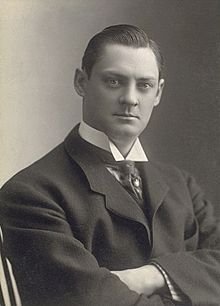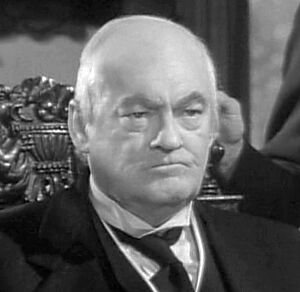Lionel Barrymore facts for kids
Quick facts for kids
Lionel Barrymore
|
|
|---|---|

Barrymore c. 1910
|
|
| Born |
Lionel Herbert Blythe
April 28, 1878 Philadelphia, Pennsylvania, U.S.
|
| Died | November 15, 1954 (aged 76) Los Angeles, California, U.S.
|
| Occupation | Actor |
| Years active | 1893–1954 |
| Political party | Republican |
| Spouse(s) |
Doris Rankin
(m. 1904; div. 1922)Irene Fenwick
(m. 1923; died 1936) |
| Children | 2 |
| Parent(s) | Maurice Barrymore Georgiana Drew |
| Family | Barrymore |
Lionel Barrymore (born Lionel Herbert Blythe; April 28, 1878 – November 15, 1954) was a famous American actor. He worked in plays, movies, and on the radio. He won an Academy Award for Best Actor for his role in the movie A Free Soul (1931). Many people today remember him best as the grumpy villain Mr. Potter in the 1946 film It's a Wonderful Life.
He was also well-known for playing Ebenezer Scrooge in radio broadcasts of A Christmas Carol every year for two decades. Another famous role was Dr. Leonard Gillespie in MGM's nine Dr. Kildare movies. He even played this character in a radio series. Lionel Barrymore was part of the famous Barrymore family of actors.
Contents
Early Life and Family
Lionel Barrymore was born in Philadelphia, Pennsylvania. His parents, Georgiana Drew Barrymore and Maurice Barrymore, were also actors. He was the older brother of two other famous actors, Ethel and John Barrymore. His family included many other actors, like his great-niece Drew Barrymore.
As a child, Lionel went to private schools, including the Art Students League of New York. He also attended Seton Hall Preparatory School.
Lionel was married twice. His first wife was actress Doris Rankin. They had two daughters, Ethel Barrymore II and Mary Barrymore, but sadly, neither child lived past infancy. Lionel was very sad about losing his daughters. Later, he became like a father figure to actress Jean Harlow. When she passed away in 1937, Lionel and Clark Gable were very upset, as if she were family.
Stage Career
At first, Lionel didn't want to be an actor like his parents. He wanted to be a painter or an artist. But at age 15, he started acting with his grandmother Louisa Lane Drew in a play called The Rivals. Even though he preferred art, he soon became successful on stage, especially in character roles.
He performed on Broadway in his early twenties. He was praised for his acting in plays like The Mummy and the Hummingbird (1902). In 1905, he acted with his brother John and sister Ethel in a pantomime show.
In 1906, Lionel and his first wife, Doris Rankin, took a break from acting and went to Paris. Lionel wanted to study art there. They were in Paris when their first daughter, Ethel, was born in 1908. He tried to be a painter but didn't find success. So, in 1909, he returned to the United States and continued his stage career. He also joined his family's vaudeville act, which was a type of variety show.
From 1912 to 1917, Lionel focused on making movies. After World War I, he returned to Broadway and became known as a strong dramatic actor. He often performed with his wife, Doris. He starred in plays like Peter Ibbetson (1917) with his brother John, and The Copperhead (1918). His last big stage success was in Laugh, Clown, Laugh in 1923, where he acted with his second wife, Irene Fenwick. After sound films became popular in 1927, he never acted on stage again.
Film Career
Lionel Barrymore started working in movies in 1909 with Biograph Studios. By 1911, he was playing main roles in films directed by D. W. Griffith. He appeared in over 60 silent films with Griffith, including The New York Hat (1912). He also helped write and direct some films. His sister Ethel starred in the last silent film he directed, Life's Whirlpool (1917).
In 1920, he starred in the movie The Copperhead, based on his stage role. He also played the main character in The Master Mind.
Before Metro-Goldwyn-Mayer (MGM) was formed in 1924, Lionel had a good relationship with Louis B. Mayer at Metro Pictures. He made several silent movies for Metro. In 1923, Lionel and his second wife, Irene Fenwick, went to Italy to film The Eternal City. In 1925, he moved to Hollywood.
In 1926, Barrymore signed a contract with MGM. His first talking picture was The Lion and the Mouse. His experience on stage helped him speak clearly in these new "talkie" films.
He also directed films during the early sound era. He was known for being the first director to move a microphone on a sound stage, which was a big deal for filmmaking back then.
Lionel returned to acting in front of the camera in 1931. That year, he won an Academy Award for his role as a lawyer in A Free Soul. He was a versatile actor and could play many different characters. He played the evil Rasputin in Rasputin and the Empress (1932), where he acted with his siblings John and Ethel for the only time. He also played Professor Zelen, an expert on the occult, in the horror film Mark of the Vampire (1935).
In the 1930s and 1940s, he often played a grumpy but kind old man. Some of these films include Grand Hotel (1932), Captains Courageous (1937), and You Can't Take It with You (1938).

He became very famous for his role as the mean banker Mr. Potter in It's a Wonderful Life (1946), starring opposite James Stewart.
In the Doctor Kildare movie series, he played the tough but caring Doctor Gillespie. He continued this role in an MGM radio series. Lionel had broken his hip, which meant he played Dr. Gillespie in a wheelchair. Later, his worsening arthritis kept him in the chair. Because of his injury, he couldn't play Ebenezer Scrooge in the 1938 MGM film A Christmas Carol. However, he played Scrooge every year on the radio from 1934 to 1953.
His last film appearance was a small role in Main Street to Broadway (1953), which also featured his sister Ethel.
Politics
Lionel Barrymore was a Republican. He supported the Republican party in elections.
During World War II, he registered for the draft even though he was older and had a disability. He did this to encourage other people to join the military.
He didn't like the income tax. When he was working on the radio show Mayor of the Town, MGM would take a large part of his paychecks to pay his taxes to the IRS.
Medical Issues
Lionel Barrymore's ability to walk changed over time. Some people say his arthritis was the main reason he used a wheelchair. By 1928, his arthritis was serious, but he could still walk with a slight limp when he won his Oscar in 1931.
However, a major reason for his wheelchair use was a broken hip. In 1936, a drawing table fell on him, breaking his hip. Then, in 1937, he tripped while filming Saratoga and broke his hip again. This second break never healed properly, making it very hard for him to walk.
By 1938, the pain from standing was so bad that he needed pain medication every hour. From then on, Lionel Barrymore used a wheelchair and never walked again. He could stand for short periods, like at his brother's funeral in 1942.
Other Talents
Lionel Barrymore was talented in many ways beyond acting.
He composed music, from piano pieces to large orchestral works. One of his orchestral pieces was played in the movie Dr. Kildare's Wedding Day (1941). When his brother John died in 1942, Lionel composed a piece called "In Memoriam," which was performed by the Philadelphia Orchestra.
He also loved art. He had gone to art school in New York and Paris and was a skilled graphic artist. He created etchings and drawings and was a member of the Society of American Etchers. He even had an art studio at his home in Los Angeles.
In 1953, he wrote a historical novel called Mr. Cantonwine: A Moral Tale. He was also a horticulturalist, meaning he enjoyed growing plants, especially roses, on his ranch.
Death
Lionel Barrymore passed away on November 15, 1954, from a heart attack in Los Angeles. He was buried in the Calvary Cemetery in East Los Angeles.
Tributes
In 1960, Lionel Barrymore received two stars on the Hollywood Walk of Fame. One star is for his work in motion pictures, and the other is for his radio work. He was also inducted into the American Theater Hall of Fame, along with his siblings, Ethel and John.
Works
See also
 In Spanish: Lionel Barrymore para niños
In Spanish: Lionel Barrymore para niños
- List of actors with Academy Award nominations








